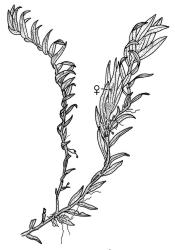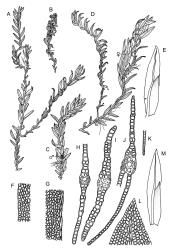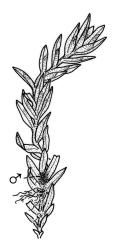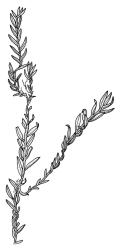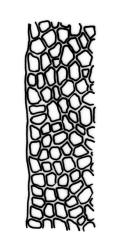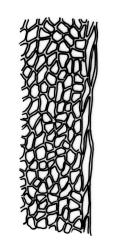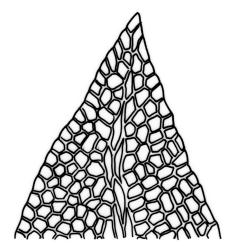Plants 10–20(–50) mm, yellow-green to dark green, loosely or densely gregarious. Stems branched, with rhizoids abundant at the base of branches, and occasionally in leaf axils; central strand present. Leaves in 12–25(–60) pairs, not overlapping at mid stem, patent, strongly decurved when moist, variably inrolled at the apex or crispate when dry, lanceolate, 1.2–2.0 × 0.25–0.45 mm; apex acute; laminae pluristratose in patches, especially near the costa; vaginant laminae ½ leaf length, closed or almost closed; dorsal lamina ending at leaf insertion or shortly decurrent, tapered to its base; margins entire; marginal cells on vaginant laminae distinct in 1–3 rows, prosenchymatous, forming a variable, weak, unistratose to pluristratose border; cells of apical and dorsal laminae quadrate to hexagonal, smooth, non-bulging, with moderately thick walls, (5–)6–11(–14) × (5–)6–11(–14) µm. Costa failing 3–5 cells below leaf apex, bryoides-type in cross-section.
Dioicous? Perichaetia terminal; perichaetial leaves longer than vegetative. Perigonia terminal on main or axillary stems of tall plants. Sporophytes unknown.
Beever & Stone 1999, fig. 1, a–p; Beever et al. 2002, p. 74, figs 1–6.
Fissidens waiensis has been assigned provisionally (in the absence of sporophytes) to subgen. Aloma (Pursell & Bruggeman-Nannenga 2004; Pursell & Müller 2008), but the dioicous sexuality would be anomalous in that group. The species has similarities to the Indian F. pseudofirmus Z.Iwats., which apparently grows in similar habitats (Iwatsuki 1987). Study of the type shows that species also has lanceolate leaves with acute apices, apical and dorsal laminae two cells thick in patches, and is bordered on the vaginant laminae margins. However, F. pseudofirmus differs in its papillose leaf margins, lack of stem central strand, and vaginant laminae that are more open and with more distinct laminal borders.
A 1927 collection by E.A. Hodgson from Lake Waikaremoana was annotated in the BM by Dixon. He compared it with F. capitatus (as F. oblongifolius var. capitatus), noting that it "seems to be a rigid, delicate, falcate-leaved form". Sainsbury, on a duplicate (WELT M010292), similarly noted "Must be F. oblongifolius [var. capitatus]. Nerve narrow and smaller vaginant lamina terminates at the margin". The species can be distinguished from both F. oblongifolius and F. capitatus by its flat, rather than strongly bulging lamina cells, and its dioicous sexuality with terminal perigonia. Leaf shape and (as Sainsbury noted, see above) the position of the termination of the vaginant laminae are deceptively similar in F. waiensis and F. capitatus, but the latter species grows on mesic soil banks and is never aquatic.
Fissidens waiensis differs from the obligate aquatic species F. integerrimus in tolerating intermittent desiccation, in the leaves being more decurved when moist, more strongly altered when dry (becoming inrolled or crispate), and in the dorsal and apical laminae being pluristratose in patches (vs uniformly unistratose in F. integerrimus). The species differ also in the shape of the leaf apex, which is more acute and more gradually tapered in F. waiensis.
Other species of Fissidens with which F. waiensis might be confused are F. leptocladus, F. strictus, and F. rigidulus. The distinctions are considered under those species.
K; NI: N Auckland, including offshore islands (HC), S Auckland, Gisborne, Hawke’s Bay (Māhia Scenic Reserve), Taranaki (Meeting of the Waters Scenic Reserve), Wellington; SI: Marlborough (Haldon Hills), Canterbury (Banks Peninsula); Ch.
Endemic.
On rock, including andesite, ignimbrite, basalt and greywacke. Aquatic, or intermittently submerged, in well-aerated fast-flowing streams, or less often in seeps. Shaded or fully exposed (e.g., on the bank of the Waikato River at Huka Falls), in both indigenous and exotic vegetation. Generally found in unpolluted waters, but occasionally in eutrophic conditions, as at Motions Creek, downstream of Auckland Zoo.
The type and other collections were made in northern coastal forest on Taranga/Hen I. in mid summer. Fissidens waiensis appeared to be relatively common on the island, and was collected in several stream beds, which at the time were merely damp or completely dry. The species appears to tolerate both permanent submergence and long periods of desiccation. It may grow in dense pure swards, mixed with other bryophytes (especially F. leptocladus), or as scattered plants in rock crevices. Associated mosses include Achrophyllum dentatum, Cratoneuropsis relaxa, Echinodium hispidum, Eurhynchium austrinum, F. leptocladus, F. rigidulus var. rigidulus, Leptodictyum riparium, Schistidium apocarpum, Thamnobryum pumilum, Thuidiopsis sparsa, and Tridontium tasmanicum. Recorded from near sea level to 600 m (Lake Waikaremoana, Gisborne L.D.).
An account of F. waiensis was given by Beever & Stone (1999).



